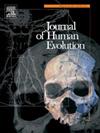Cranial vault thickness, its internal organization, and its relationship with endocranial shape in Neanderthals and modern humans
IF 3.1
1区 地球科学
Q1 ANTHROPOLOGY
引用次数: 0
Abstract
Compared to the more elongated crania of Neanderthals, modern humans have a rounder, more globular cranial vault. The factors contributing to this globular cranial and endocranial morphology remain poorly understood. Cranial vault thickness (CVT) plays a role in shaping the braincase. It has been proposed that CVT variation in hominins reflects distinct stimuli influencing the cranial vault layers to different degrees. We aim to determine to what extent CVT differences could explain the well-documented endocranial shape differences between modern humans and Neanderthals. Additionally, we quantify the contributions of each cranial vault layer—the inner and outer tables and the diploë—to elucidate the processes driving CVT variation. We analyzed crania from seven Neanderthals and 75 modern humans using a ray casting method to measure cortical, diploic, and overall CVT. We generated morphometric maps of thickness distributions for each cranial vault layer. We then quantified the endocranial shape using geometric morphometrics and analyzed its relationship with CVT using two-block partial least squares analysis and regression models. Our findings reveal that Neanderthals generally have greater CVT and thicker layers of the cranial vault than modern humans. However, their ranges overlap with those of modern humans. The thicker vaults of Neanderthals are primarily driven by the diploic layer, with notable differences in thickness distribution patterns. Additionally, the inner and outer cortical tables exhibit distinct thickness distribution patterns between the two groups. Structural differences between the parietal bones of Neanderthals and modern humans are particularly pronounced. Furthermore, we observed a unique correspondence between CVT and endocranial shape in modern humans, which is not shared by Neanderthals.
尼安德特人和现代人的颅顶厚度,其内部组织及其与颅内形状的关系
与尼安德特人更细长的颅骨相比,现代人有一个更圆、更球形的颅顶。导致这种球形颅骨和颅内形态的因素仍然知之甚少。颅顶厚度(CVT)在颅脑成形中起着重要作用。有人提出,古人类CVT的变化反映了不同的刺激在不同程度上影响了颅穹窿层。我们的目标是确定CVT差异在多大程度上可以解释现代人和尼安德特人之间有充分记录的颅内形状差异。此外,我们量化了每个颅拱顶层的贡献-内部和外部表和diploë-to阐明了驱动CVT变化的过程。我们使用射线投射法分析了7名尼安德特人和75名现代人的颅骨,测量了皮质、外交和整体CVT。我们生成了每个颅穹窿层厚度分布的形态测量图。然后,我们使用几何形态计量学量化颅内形状,并使用双块偏最小二乘分析和回归模型分析其与CVT的关系。我们的研究结果表明,尼安德特人通常比现代人拥有更大的CVT和更厚的颅顶层。然而,他们的活动范围与现代人类重叠。尼安德特人较厚的拱顶主要是由外交层驱动的,在厚度分布模式上有显著差异。此外,内外皮层表在两组之间表现出不同的厚度分布模式。尼安德特人和现代人顶骨的结构差异尤为明显。此外,我们还观察到现代人CVT与内颅形状之间的独特对应关系,这在尼安德特人身上是不存在的。
本文章由计算机程序翻译,如有差异,请以英文原文为准。
求助全文
约1分钟内获得全文
求助全文
来源期刊

Journal of Human Evolution
生物-进化生物学
CiteScore
6.30
自引率
15.60%
发文量
104
审稿时长
3 months
期刊介绍:
The Journal of Human Evolution concentrates on publishing the highest quality papers covering all aspects of human evolution. The central focus is aimed jointly at paleoanthropological work, covering human and primate fossils, and at comparative studies of living species, including both morphological and molecular evidence. These include descriptions of new discoveries, interpretative analyses of new and previously described material, and assessments of the phylogeny and paleobiology of primate species. Submissions should address issues and questions of broad interest in paleoanthropology.
 求助内容:
求助内容: 应助结果提醒方式:
应助结果提醒方式:


